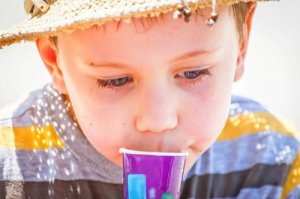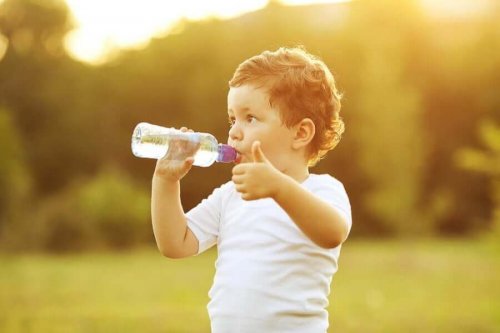Heatstroke in Children: How to Act

Heatstroke in children occurs as a result of exposure to high temperatures and the intensity of the sun’s rays, characteristic of the summer season. This disorder can cause cramping, dizziness, dehydration, and other discomforts. It’s also known as hyperthermia or overheating due to the malfunction of the body’s regulatory centers.
If you observe that a child has symptoms of heatstroke, you must act immediately. The first thing you must do is call the emergency department of the country where you are and, while help arrives, place the child in a dark, cool room, applying cold baths or damp cloths on the skin to cool the child’s body.
During the summer, the notion of wearing light clothes or staying under the shade from time to time may seem unimportant; however, in reality, this can prevent heatstroke in children from getting worse.
What should you know about heatstroke in children?
Heatstroke in children may seem like a mild disorder, but it’s not. In fact, it can severely affect the kidneys, muscles, heart, and brain. Hence, when you see any symptoms, you must act immediately.
The matter can get worse the longer you take to apply first aid. Moreover, if the child doesn’t receive proper treatment, the outcome can be fatal.

Symptoms of heatstroke
- Dizziness.
- Nausea.
- Vomiting.
- Agitation.
- Extreme thirst.
- Headache.
- Hyperventilation.
- Dry and flushed skin.
- Low urination frequency.
- Temperature above 40 °C (104 °F)
- Irritability and crying (especially in babies).
- Confusion and difficulty concentrating. They may also have difficulty pronouncing words.
- Palpitations, altered pulse, and general weakness. The child will lack strength and will have a fast heartbeat.
- In more severe cases, seizures may occur.
Treatment for heatstroke in children
Parents should keep their children in the shade or in a dark room when a heatstroke takes place. They should also take off their clothes or leave them with the lightest clothing possible so that they cool down and let their temperature drop.
Likewise, try to refresh their body while medical help arrives; either with damp cloths or cold showers. It’s important that when you immerse a child in a tub of fresh water, you do it little by little and not at once.
You can use a spray bottle to spray the child’s body with fresh water before immersing the child in the tub. At the same time, you should fan the child and put damp cloths in places such as the neck, armpits, and groin.
Safety measures to apply
To avoid heatstroke in children, it’s important to take into account some simple measures that are available to everyone. Parents should only pay attention to these recommendations in months of intense heat or when their children are in very hot places.
- Put sunscreen on them as well as caps and appropriate clothing; light cotton and fabrics that allow perspiration.
- Make sure that children stay well hydrated and that they drink water throughout the day. They can also drink natural juices.
- When they’re at home, prevent sun rays from entering directly with the help of curtains, windows, or blinds.
- Don’t let them do intense exercises outdoors without parental supervision.

In addition to the above safety measures, you should carry out the following recommendations to avoid complications:
- Avoid prolonged exposure to the sun, especially during hours of higher radiation, such as midday.
- Don’t leave children inside vehicles or rooms without ventilation.
- If the child is enrolled in any activity, make sure it takes place in the coolest hours of the day or when the sun is low.
When should you see a doctor?
When a child has the first symptoms of heatstroke, such as headache, nausea, and vomiting, it means you have to immediately go to a cool and shady location to apply the above measures.
In case the child presents symptoms of the second stage of heatstroke, like cramps, body temperature greater than 40 °C (104 °F), seizures, weakness, and disorientation, parents should contact the doctor for immediate attention. While help arrives, try to hydrate the baby or child and raise his or her legs to counteract the shock.
Heatstroke can greatly affect children’s health. Thus, taking preventive measures and staying continuously informed will be essential for parents.
Heatstroke in children occurs as a result of exposure to high temperatures and the intensity of the sun’s rays, characteristic of the summer season. This disorder can cause cramping, dizziness, dehydration, and other discomforts. It’s also known as hyperthermia or overheating due to the malfunction of the body’s regulatory centers.
If you observe that a child has symptoms of heatstroke, you must act immediately. The first thing you must do is call the emergency department of the country where you are and, while help arrives, place the child in a dark, cool room, applying cold baths or damp cloths on the skin to cool the child’s body.
During the summer, the notion of wearing light clothes or staying under the shade from time to time may seem unimportant; however, in reality, this can prevent heatstroke in children from getting worse.
What should you know about heatstroke in children?
Heatstroke in children may seem like a mild disorder, but it’s not. In fact, it can severely affect the kidneys, muscles, heart, and brain. Hence, when you see any symptoms, you must act immediately.
The matter can get worse the longer you take to apply first aid. Moreover, if the child doesn’t receive proper treatment, the outcome can be fatal.

Symptoms of heatstroke
- Dizziness.
- Nausea.
- Vomiting.
- Agitation.
- Extreme thirst.
- Headache.
- Hyperventilation.
- Dry and flushed skin.
- Low urination frequency.
- Temperature above 40 °C (104 °F)
- Irritability and crying (especially in babies).
- Confusion and difficulty concentrating. They may also have difficulty pronouncing words.
- Palpitations, altered pulse, and general weakness. The child will lack strength and will have a fast heartbeat.
- In more severe cases, seizures may occur.
Treatment for heatstroke in children
Parents should keep their children in the shade or in a dark room when a heatstroke takes place. They should also take off their clothes or leave them with the lightest clothing possible so that they cool down and let their temperature drop.
Likewise, try to refresh their body while medical help arrives; either with damp cloths or cold showers. It’s important that when you immerse a child in a tub of fresh water, you do it little by little and not at once.
You can use a spray bottle to spray the child’s body with fresh water before immersing the child in the tub. At the same time, you should fan the child and put damp cloths in places such as the neck, armpits, and groin.
Safety measures to apply
To avoid heatstroke in children, it’s important to take into account some simple measures that are available to everyone. Parents should only pay attention to these recommendations in months of intense heat or when their children are in very hot places.
- Put sunscreen on them as well as caps and appropriate clothing; light cotton and fabrics that allow perspiration.
- Make sure that children stay well hydrated and that they drink water throughout the day. They can also drink natural juices.
- When they’re at home, prevent sun rays from entering directly with the help of curtains, windows, or blinds.
- Don’t let them do intense exercises outdoors without parental supervision.

In addition to the above safety measures, you should carry out the following recommendations to avoid complications:
- Avoid prolonged exposure to the sun, especially during hours of higher radiation, such as midday.
- Don’t leave children inside vehicles or rooms without ventilation.
- If the child is enrolled in any activity, make sure it takes place in the coolest hours of the day or when the sun is low.
When should you see a doctor?
When a child has the first symptoms of heatstroke, such as headache, nausea, and vomiting, it means you have to immediately go to a cool and shady location to apply the above measures.
In case the child presents symptoms of the second stage of heatstroke, like cramps, body temperature greater than 40 °C (104 °F), seizures, weakness, and disorientation, parents should contact the doctor for immediate attention. While help arrives, try to hydrate the baby or child and raise his or her legs to counteract the shock.
Heatstroke can greatly affect children’s health. Thus, taking preventive measures and staying continuously informed will be essential for parents.
All cited sources were thoroughly reviewed by our team to ensure their quality, reliability, currency, and validity. The bibliography of this article was considered reliable and of academic or scientific accuracy.
- Pinacho-Velázquez, J. L. (2014). ”Golpe de calor en los niños”. Revista Mexicana de Pediatría, 81(3), 115-119. http://www.medigraphic.com/pdfs/pediat/sp-2014/sp143h.pdf.
- Díaz Santos, C. (2017). ”Golpe de calor y fármacos”. Repositorio abierto de la Universidad de Cantabria. https://repositorio.unican.es/xmlui/bitstream/handle/10902/11733/D%C3%ADaz%20Santos%20Carlos.pdf?sequence=4&isAllowed=y.
This text is provided for informational purposes only and does not replace consultation with a professional. If in doubt, consult your specialist.








